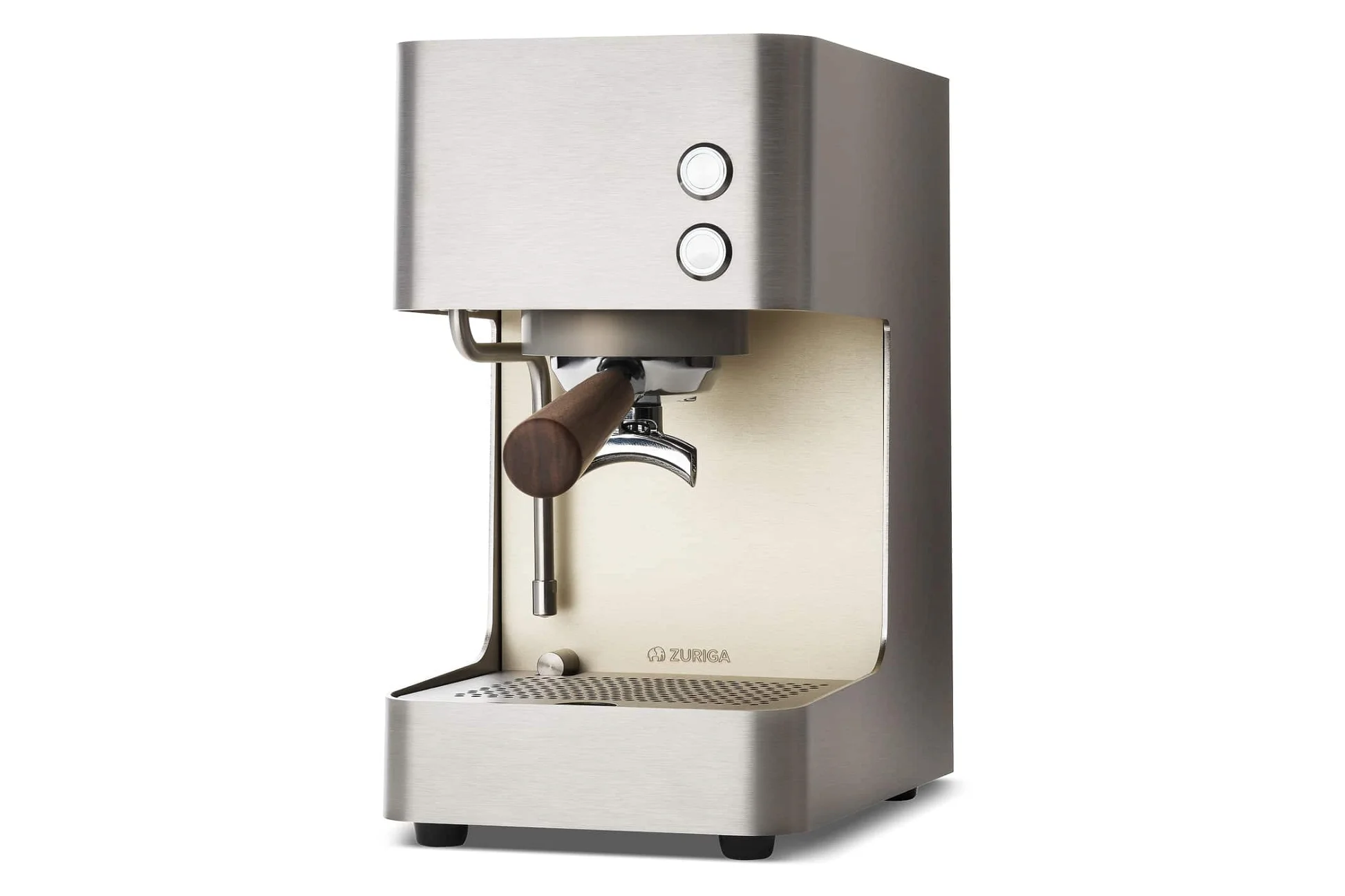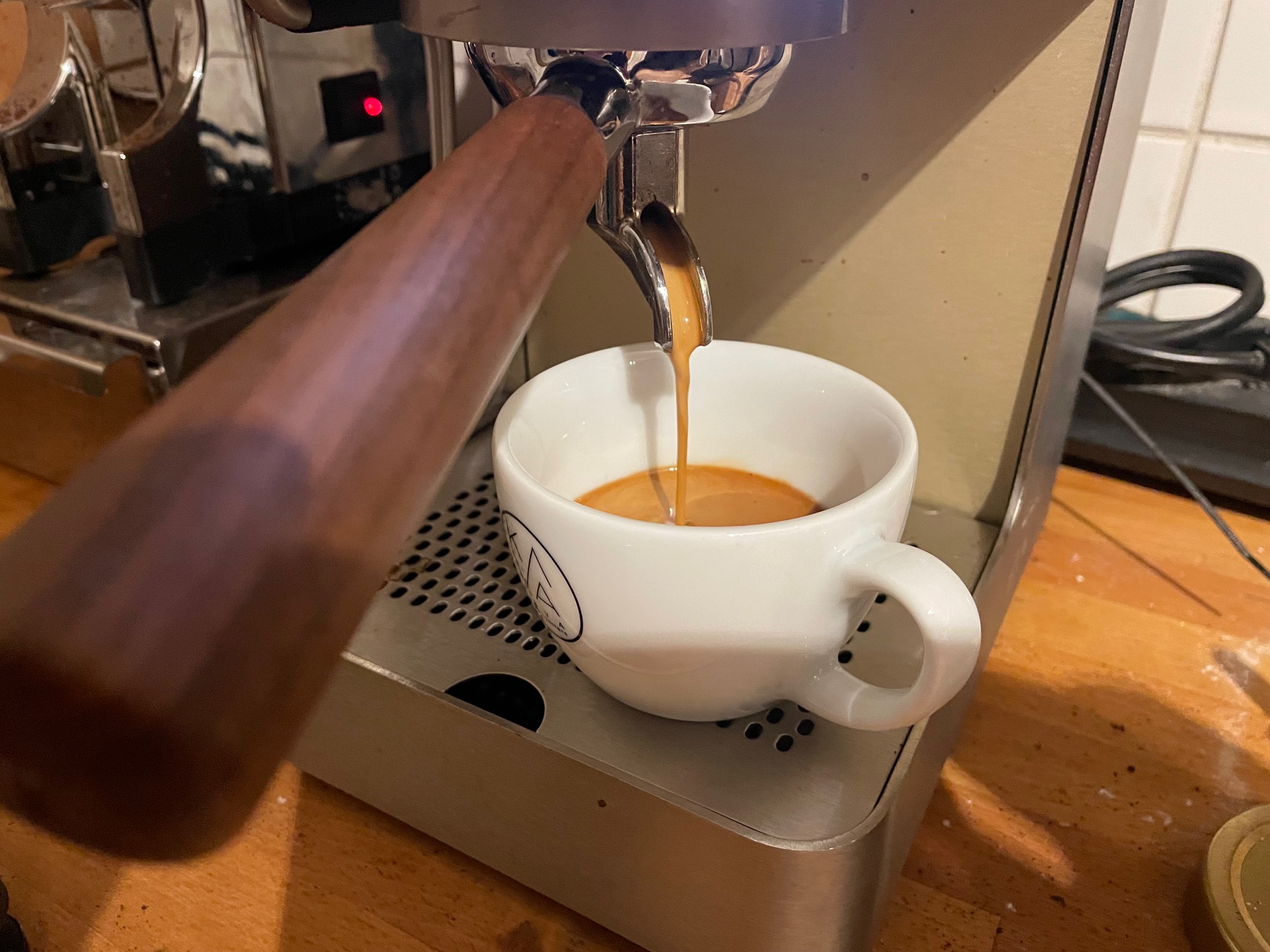Reviewing the Zuriga E2-S espresso machine
Content warning: Blatant consumerism. This is a post about espresso machines. Nobody NEEDS an espresso machine in their home. These things are an expensive luxury, and a superfluous indulgence. There are better ways to spend your money, for example by giving it to people who have less than you. The decision to buy one isn’t easy to reconcile with the desire for a better world where resources are more fairly distributed. Seen that way, buying this sort of thing is a moral failing, which I’m guilty of.
It is a truth universally acknowledged, that a man in his middle age, whether or not he is in possession of a good fortune, must be in want of an espresso machine.
I like espresso. Indeed, I like espresso so much that over time, I’ve learned to distinguish good espresso from bad. In 2007 I picked up a Pavoni Europiccola on eBay. It’s perhaps the simplest possible portafilter machine out there. Here’s a short video of James Bond using one to make an amazingly bad espresso.
It’s not just a design classic. It also taught me a lot, especially about all the things that can go wrong when making espresso: machine not hot enough; machine too hot; wrong amount of water; wrong amount of pressure; and so forth. Through all the wrestling, I really grew to like my Europiccola. Plural, actually: I ended up buying a couple more, and using them for parts, ending up with something like Theseus’ espresso machine.
Longing for comfort#
Still, after about 15 years of pulling on the Europiccola’s lever, I felt it was time for an upgrade. As one does, I spent a lot of time online, looking for the right thing. That involved deciding what I actually wanted and needed.
Did it need to be large? No. I’m currently more or less the only person in the house who drinks coffee. It should be able to serve a few guests without breaking a sweat; but I certainly don’t need a café-level device. Quite to the contrary: our kitchen is pretty small. Space is at a premium, and I can’t be blocking a metre of counter space with an oversized machine that doubles as a space heater.
Of course, I wanted something that makes a good espresso, as well as milk foam. How much control do I really want, though? Some machines will ask you to adjust the water temperature, the pressure coming from the pump, and other parameters.
I decided that I didn’t want that. I want to drink coffee, not write a dissertation about it. This let me cross a whole bunch of machines off the list.
Enter the Zuriga#
Finally, I stumbled on the Zuriga E2-S. It’s developed and built by a startup in Switzerland who seem to be doing generally solid work, and it matched what I wanted: a small machine without too many bells and whistles.
Yes, it was (and is) comparatively expensive. On the other hand, we’re talking about home espresso machines — a product category that is the very embodiment of pointless luxury. If you’ve decided to drop a stack of bills on one, there’s not much use in pinching pennies. If you want to save money, just don’t buy an espresso machine. You’ll be fine, I promise.
Aaaanyway. At the time, Zuriga would build your machine only after you’d ordered it, and paid for it. I did that, and after about two months, my machine arrived by mail. The unboxing experience was actually fun: The packaging was entirely plastic-free. They’ve designed the box such that you can use it to ship the machine back to them for maintenance. Smart!
 Image from zuriga.ch
Image from zuriga.ch
The machine itself is built like a rock. Most of the body is formed from a single thick sheet of stainless steel. When the apocalypse comes, I’ll be using this for cover as I shelter from the bullets of roving bandits, until they’ve come close enough for me to bash their heads in with my trusty ThinkPad.
The water tank is made of glass, not plastic. The tank cover is just a (nice!) piece of wood. It’s all very simple, and fits together very well.
Unlike a lot of machines in the price range, this one comes with pretty much all the accessories you’d want: A little jug for frothing milk, a tamper, small and large sieve, single and double runouts for the coffee, as well as a blind sieve (needed for cleaning).
The manual is a thing of beauty: Not only is it actually useful, it’s also designed by someone who knows about layout and typography. I frankly didn’t expect to come across a manual like this in the 21st century anymore.
Let’s have some espresso!#
After the first-run ceremony described in the manual, it turned out that making espresso on the Zuriga really is as simple as I hoped it would be.
The machine takes just two minutes to heat up. There’s no need to leave it on all the time, so it won’t consume much power. In fact, after 15 minutes it goes to sleep.
It’s a single-circuit design. But in practice, this isn’t a disadvantage. To make milk foam, you just flip out the nozzle. The LEDs on the machine go from white to orange, letting you know that the steam mechanism is engaged. It takes about 20 seconds to heat up — just enough time to get the milk from the fridge, pour it in the jug, and wipe your counter a little. And then it’s ready to blast your milk. Once you’re done, just flip the nozzle back. The Zuriga will immediately be ready to make more coffee.

Every 4-8 weeks, it’s a good idea to clean the brewing group. This is no trouble at all. Just take away all the loose parts, flip the machine on its head, and open a single Allen head screw. Wash everything, and put it back. Taking out the seal can be a bit fiddly, but otherwise the process couldn’t be easier. This is what good design does.
The way the machine is designed, it should last a long time. There are no moving parts except the pump. There’s nothing that’s pressed into anything else, where you’d have mechanical wear and tear. Everything is either a fixed part of the machine, or is held in place by gravity alone.
…but my fiddles!#
There’s nothing to adjust here, nothing to tweak. The Zuriga will always deliver water at 93°C and 15 bars of pressure.
The parameters you can influence are outside the machine: How finely you grind the coffee; how much you tamp it; for how long you let the water run.
If you want to have more control over every detail, the Zuriga isn’t the device for you. Buy something else.
That’s probably not enough for a dedicated coffee freak. But for me, it’s plenty. I can get pretty much everything I want out of that machine. The Zuriga is a paragon of Swiss stolidity. It does this one thing, exceedingly well.
Compared to the Europiccola with its volatile temper, the Zuriga is much less brutal with the coffee’s aromas, and I’ve ended up using ligher roasts for the most part.
So, in sum#
After two years of daily use, I’m still in love with the Zuriga. There’s a few things one might quibble with, though none of them are a dealbreaker for me:
- Yeah, it’s expensive for what it does. See above. Also, you might discover that your grinder isn’t as good as you thought it was, and you need a better one.
- There’s a little basin for water that the machine expels as it works. This is made of plastic, and feels a little cheap. It’s invisible during normal operation though.
- The cover over the tank is just held in place by gravity. It also has the job of pushing the silicon water hose down into the tank. This works, but is considerably less refined than the overall design. On the plus side, it’s definitely not more complicated than it needs to be.
I’m really happy with this machine. It makes very good coffee. It’s nice to look at, and it’s fun to use. It doesn’t use much space or energy. It causes no trouble. It’s a reliably happy part of my day.
Note that according to the website, the company currently only sells to Switzerland, Austria, and Germany. I’m not sure how to get one if you’re not in one of those countries, but maybe talk to them?